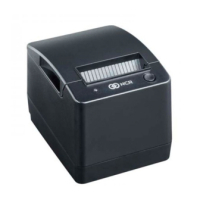7197 Series II Owner’s Guide Chapter 6: Commands
August 2011
188
Range of c1,c2:
Japanese
(CP932)
F0 ≤ c1 ≤ F9, 40 ≤ c2 ≤ 7E and 80 ≤
c2 ≤ FC
Simplified
Chinese
(CP936)
A1 ≤ c1 ≤ A7, 40 ≤ c2 ≤ 7E and 80 ≤
c2 ≤ A0, AA ≤ c1 ≤ AF, A1
≤ c2 ≤
FE, F8 ≤ c1 ≤ FE, A1 ≤ c2
≤ FE
Korean
(CP949)
c1 = C9 and c1 = FE, A1 ≤ c2 ≤ FE
Traditional
Chinese
(CP950)
81 ≤ c1 ≤ A0 and FA ≤ c1 ≤ FE, 40 ≤
c2 ≤ 7E and 80 ≤ c2 ≤ FE
C7 ≤ c1 ≤ C8, A1 ≤ c2 ≤ FE
Defines and enters downloaded characters into RAM. The user-defined character will be
cleared by ESC @ or power off of printer. Each character requires 72 bytes for character
definition.
The maximum number of user-defined character is 100.
Example:
MSComm1.Output = Chr$(&H1C) & Chr$(&H32) & Chr$(&HF0) & Chr$(&H40) &
Chr$(d1) & Chr$(dn)
Set Kanji character spacing
ASCII: FS S n1 n2
Hexadecimal: 1C 53 n1 n2
Decimal:
28 83 n1 n2
Value of n1:
Ignored (0)
Value of n2:
Character right side spacing dots (1/203 inch)
Default of n2:
1 for 1 byte character, 2 for 2 bytes character
Sets the character right side spacing for characters in Asian character.
The underline is valid on the space set by this command. ESC SP command is not valid for
Asian character code pages. Therefore, this command is used to set the character right side
spacing for characters in Asian code page.

